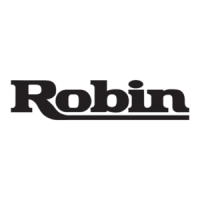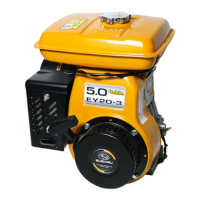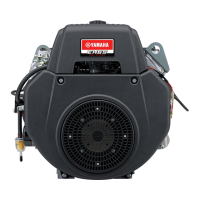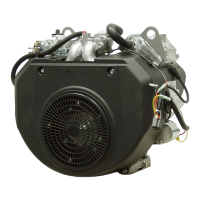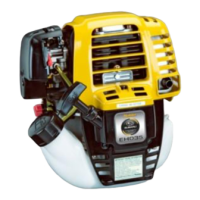Do you have a question about the Robin America EY44-2 and is the answer not in the manual?
Defines maximum power developed after run-in, with fully open throttle valve. New engines may not reach it initially.
Power developed at optimum speed for engine life and fuel efficiency. Must be the limit for driving systems.
Driving torque at max. output and fuel consumption ratio at that output.
Illustrates the engine's components with labels for identification.
Describes the crankcase construction, made of aluminum die-cast and separable.
Details the aluminum die-cast main bearing cover for engine interior access.
Explains the crankshaft is machined from carbon steel forging with hardened crank pin.
Describes connecting rod from aluminum alloy forging and piston from aluminum alloy casting.
Details the carbon steel forging camshaft with integral cams and gears.
Explains cylinder is cast iron with fins, head is aluminum alloy casting.
Positions exhaust valve upstream of cooling air for intensive cooling and durability.
Describes the balancer system to reduce vibrations from crankshaft and piston.
Explains the centrifugal flyweight governor for constant-speed operation.
Details the cooling fan, serving as flywheel, directing air to cylinder head.
Describes lubrication by scooping and splashing oil with oil scraper.
Explains flywheel magneto ignition system with timing set at 23° before TDC.
Introduces the horizontal draft carburetor for optimal performance.
Describes the impinge type semi-wet air cleaner using felt for dust capture.
Explains selenium rectifier converts AC to DC for battery charging.
Provides guidance on noting part positions, cleaning, and tool usage before disassembly.
Lists and illustrates special tools required for disassembly and reassembly.
Details steps for removing and reinstalling the fuel tank and bracket.
Covers removal of blower housing, muffler cover, and cylinder baffle.
Explains how to remove and clean the air cleaner element.
Describes the process of removing the muffler.
Details removing the governor lever and the carburetor.
Covers removal of starting pulley, flywheel, ignition coil, and breaker assembly.
Provides steps for detaching the cylinder head and spark plug.
Outlines removing tappet covers, valve springs, retainers, and valves.
Details detaching the cylinder block and reassembly precautions.
Explains how to remove the main bearing cover.
Covers removal and reassembly of camshaft and tappets.
Details disassembly and reassembly of connecting rod and piston components.
Explains how to remove the crankshaft from the crankcase.
Details engine mounting position, coupling, and anchoring for convenience.
Emphasizes fresh air supply for cooling/combustion; warns against enclosed spaces.
Stresses exhausting toxic gas outdoors and sizing duct diameter.
Guides fuel tank placement, piping, and recommends minimizing length.
Offers advice on V-belt use, shaft alignment, pulley alignment, and mounting.
Advises minimizing runout and misalignment for flexible couplings.
Details wiring connections for rope starting and electric start engines.
Describes the magneto as the source of ignition spark.
Details the procedure for adjusting the breaker point gap for optimal spark.
Explains how to adjust spark timing using a timing light.
Provides troubleshooting steps for magneto-related engine problems.
Explains the float system, pilot system, main system, and choke system of the carburetor.
Details removing the throttle valve and shaft.
Covers removal of choke valve, shaft, ball, and spring.
Explains how to remove and reinstall the pilot jet and screw.
Details removing the main jet holder, main jet, and main nozzle.
Covers removing the float pin, float, and needle valve.
Guides adjusting the pilot screw and throttle top screw.
Details fuel system issues like no fuel, improper choke, or contaminated gasoline.
Covers compression problems like dry cylinders, loose spark plugs, or valve issues.
Lists checks for no spark issues like disconnected cables or faulty ignition components.
Identifies causes for engine misfires, including spark plug gap, weak spark, or poor compression.
Lists reasons for engine stalling, such as fuel tank issues, vapor lock, or ignition problems.
Explains causes of engine overheating like low oil, incorrect timing, or poor cooling.
Identifies causes of engine knocks, including poor fuel quality, carbon deposits, or incorrect timing.
Lists reasons for engine backfires, such as water in fuel, sticky valves, or cold engine.
Outlines daily checks for dust, fuel leaks, screw tightening, and oil level.
Specifies changing crankcase oil to remove run-in wear particles.
Includes changing oil, cleaning air cleaner, and checking spark plug.
Recommends cleaning fuel filter, fuel tank, and contact breaker points.
Details removing cylinder head carbon deposit and cleaning the carburetor.
Involves performing overhauls, cleaning, correcting, or replacing parts and piston rings.
Provides steps for preparing the engine for extended storage.
| Brand | Robin America |
|---|---|
| Model | EY44-2 |
| Category | Engine |
| Language | English |

